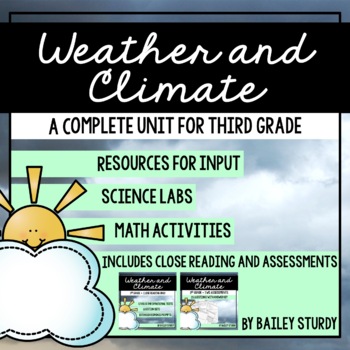3rd Grade NGSS Weather and Climate Unit
- Zip
What educators are saying
Also included in
- This bundle includes all 4 units for third grade! You will find:Resources for InputInquiry ChartsObservation ChartsBig Book (PPT and printable)Pictorial and Comparative Input Chart templates (16 total)SocialityContinental DriftGeologic Time ScaleNatural SelectionAdaptationsEcosystem DynamicsForces oPrice $42.00Original Price $57.50Save $15.50
Description
This unit includes resources for providing scientific input about weather and climate, along with close readings, math activities, and science labs.
Resources for Input:
- Unit essential question
- Inquiry chart printable
- 7 observation chart photos
- Printable CCD and teacher samples
- The Important Thing About Weather and Climate Big Book (1 title page, 7 content pages, 6 pages of pictures)
- PPT version of the big book
- Super Scientist Awards
- 4 pictorial and/or comparative input charts to project and trace, with extra pictures and demo activities
- Weather vs Climate
- What Affects Climate?
- Climates Around the World
- Hurricanes vs Tornadoes
- 2 chants
- Climates Here, Climates There
- Natural Hazard Bugaloo)
- 3 different printable sentence pattern charts and teacher sample
- Climate Types Expert Groups (set of 5) with mind map graphic organizer and process grid. Climates are:
- Polar
- Arid
- Continental
- Temperate
- Tropical
- Natural Hazard Expert Groups (set of 6) with mind map graphic organizer and process grid. Hazards are:
- Tornadoes
- Hurricanes
- Floods
- Drought
- Wildfire
- Blizzards
- Avalanches
- 3 writing prompts (narrative, informational, and opinion) and writing paper
Close Reading
- 4 informational texts organized into 3 close reading sets. Each set includes:
- Essential question
- 3 printable question sets aligned to CCSS
- 2 extended response/journal prompts
These are available digitally as Google Slides presentations. Each leveled text, and its corresponding question sets and journal prompts are in their own presentation. That's 9 presentations total.
Titles:
- Meteorology
- Tri-State Tornado/Galveston Hurricane (paired texts)
- Seasons and the Earth
Please note that these are the same close readings as the ones in the 3rd Grade Weather and Climate Close Reading packet and the 3rd Grade NGSS Close Reading Bundle.
Math Activities
- 4 math activities (2 center-type activities and 2 sets of printables)
- Titles:
- Massive Natural Disasters (mass/volume word problem task cards)
- Costliest Hurricane//Avalanche! (graphing printables)
- Partly Sunny Properties of Multiplication (printables)
- Rolling Out Rounding (dice activity)
Science Labs
- 6 science labs with teacher directions and printable recording sheets
Titles:
- Weather Multimedia Text Set -- includes a Google Slides™ presentation linked with sources for student exploration. Please NOTE the content in each link is not my property. While I do try to make sure the links are still working, you may need to provide an alternate source in the event that a source stops working.
- Build an Anemometer -- Engineering Design Challenge
- Weather Conditions by Climate -- track weather conditions in climates across the US
- Climate Graphing Task Cards
- The Water Cycle
- Weather Hazard Solution Design Challenge -- design a house to withstand the effects of a natural hazard; 4 options included
Art Integration
- Printables of 7 works of art
- Discussion questions for each work relating art to science
- 1 art lesson
Assessments
NOTE: These assessments are available separately here. There is no need to buy both if you intend to purchase the unit.
- 2 Assessments and Answer Keys
Assessment 1: Weather and Climate (17 questions)
Assessment 2: Weather Hazards (8 questions)
Bonus:
- Brief unit overview with suggestions for pacing
- Answer keys for the standards-based close reading questions, math activities, and 1 of the science activities
You may also like:
Weather and Climate Digital Packet






